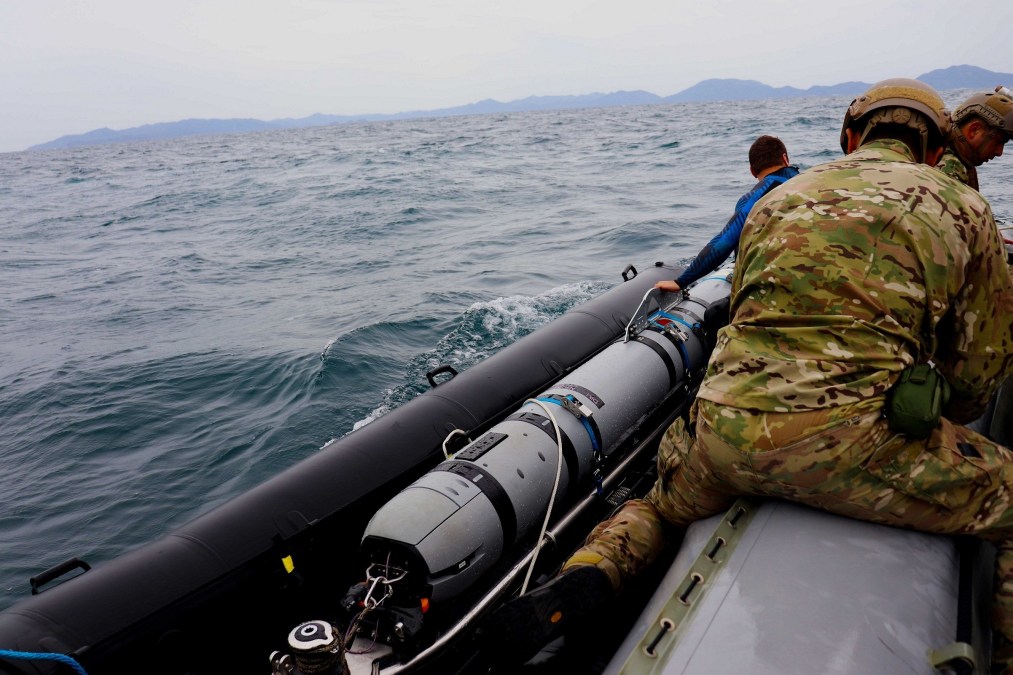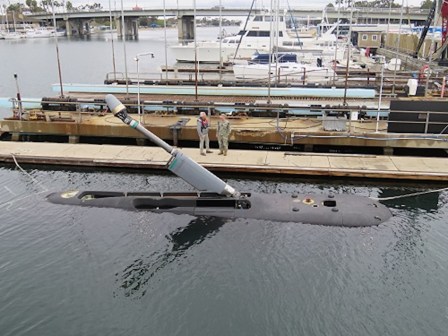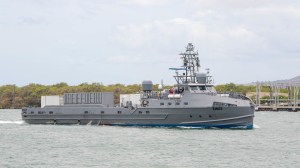Navy issues RFI for unmanned ‘mother ship’ that could deploy other drones

The Navy is conducting market research to see if contractors would be able to satisfy anticipated program requirements for a new unmanned “Attritable UxS Mother Ship” that could launch other robotic platforms on the high seas.
The sea service is exploring this AUMS concept as it looks for a way to cost-effectively deliver large numbers of unmanned systems, or UxS, to forward locations in a contested environment. Having a low-cost, uncrewed, “attritable” vessel that could perform this task would allow the Navy to avoid putting manned ships into harm’s way to conduct these missions.
AUMS systems “shall be unmanned and capable of following waypoints and navigating via GPS. Design considerations should account for lack of GPS, but with a focus on the trade space of cost to navigate without GPS vs. navigational drift. Also, concepts should consider Over The Horizon (OTH) communications and Line Of Sight (LOS) communications as a means of providing basic tasking to the platform and maintaining situational awareness of the platform,” according to an RFI released this week.
The price tag for such a system is a major concern. The Navy noted that “cost containment” is the “single most important goal of the AUMS design and approach.”
The notional system would be able to traverse 1,500 nautical miles in the open ocean with a top speed of 12 to 20 knots and an endurance of up to five days.
Key performance parameters include autonomy capabilities such as navigation autonomy to safely provide path planning, static obstacle avoidance, optimal weather routing and payload delivery behaviors, according to the RFI.
The platform would also need to have 360-degree camera coverage and a full-motion video uplink, possess cybersecurity features, be resistant to boarding and physical tampering from unauthorized personnel and have a “self-scuttling” capability upon remote order, among other attributes.
The idea is for the AUMS to be able to carry a modularized ISO container filled with unmanned systems that could be deployed at a desired location.
The vessel “must be able to support a 20 ft. ISO container, either directly onboard or via a towed body, whichever can be achieved at a lower cost. If the ISO container is carried directly onboard, there must be a system to push it over the side,” the RFI notes. “Upon reaching the drop-off location, the 20 ft. ISO container with UxVs will be self-sustaining and can just be deployed and left; there is no requirement for AUMS to loiter in the area.”
Government-furnished equipment would include the ISO container, UxVs, and a command, control, communications, computers and intelligence (C4I) suite.
The Navy is eyeing modular open system approaches to give it the ability to quickly insert new technology during platform upgrades and support expansion of navigation autonomy.
The sea service is “looking for the most efficacious approach with industry to rapidly deliver this capability to include leveraging existing commercial, manned or unmanned surface ship designs that can be re-designed and/or modified. A clean slate design will be considered if it can be demonstrated to be the most beneficial to the Navy,” according to the RFI.
The Navy said it may award a design and construction contract for an AUMS system in fiscal 2026, with the hope that industry could potentially deliver the first vessels within 24 months. It envisions a notional class of 11 platforms.
Responses to the RFI are due by Dec. 15.
Meanwhile, the service is also looking forward to using manned submarines as a “mothership” for deploying underwater drones.
Leidos and L3Harris are working on a medium-sized unmanned undersea vessel (UUV) that is expected to provide intelligence, surveillance and reconnaissance capabilities for the submarine force and the explosive ordnance disposal community. The contract to design and build the system, worth up to $358 million, was awarded in July.
The program recently completed an integration baseline review and is about to execute system requirements and system functional reviews, according to Rear Adm. Casey Moton, the Navy’s program executive officer for unmanned and small combatants.
The program team will “leverage work done for the existing Razorback UUVs, which were designed to operate from a dry deck shelter or from a craft of opportunity,” he said Wednesday at the Naval Submarine League’s annual symposium in Arlington, Virginia.
“The new Razorback vehicle will be a fully integrated payload for use by the SSN [attack submarine] fleet. And to accomplish this feat a torpedo tube launch and recovery capability will be integrated into the Razorback UUV,” he said. “When this game-changing capability is deployed, every SSN will have the ability to serve as a UUV mothership.”






